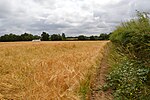Highwood, Essex
City of ChelmsfordCivil parishes in EssexEssex geography stubsVillages in Essex

Highwood is a village and civil parish in the Chelmsford district of Essex, England. The village is approximately a mile south from the A414 road and four miles west from the centre of the county town of Chelmsford. Loves Green is part of the village at its north. The hamlet of Edney Common is at the east of the parish. In 2011 the parish had a population of 654.
Excerpt from the Wikipedia article Highwood, Essex (License: CC BY-SA 3.0, Authors, Images).Highwood, Essex
Highwood Road, Chelmsford Highwood
Geographical coordinates (GPS) Address Phone number Website Nearby Places Show on map
Geographical coordinates (GPS)
| Latitude | Longitude |
|---|---|
| N 51.7105 ° | E 0.3739 ° |
Address
Highwood Primary School
Highwood Road
CM1 3QH Chelmsford, Highwood
England, United Kingdom
Open on Google Maps











